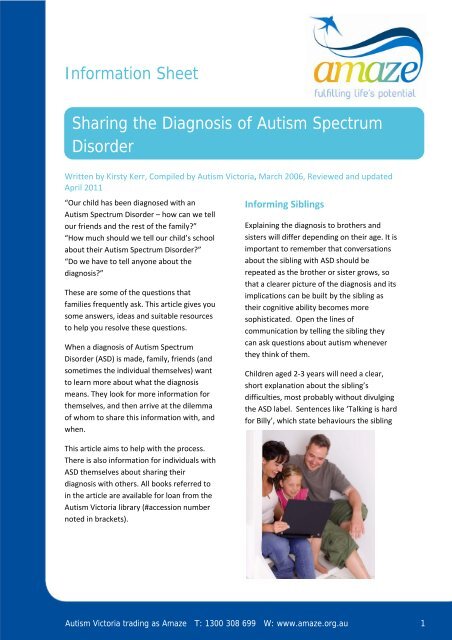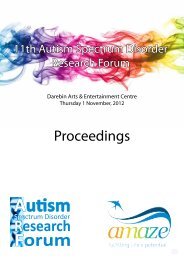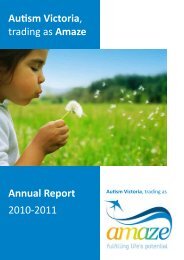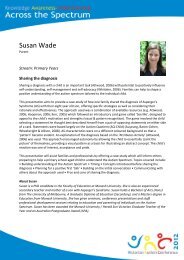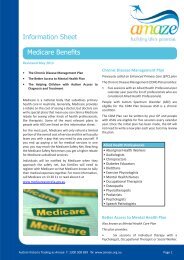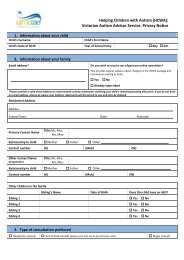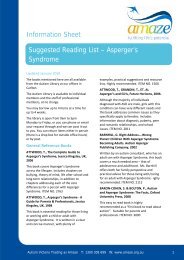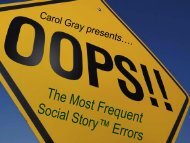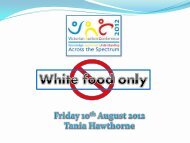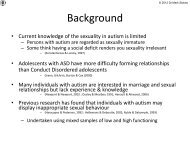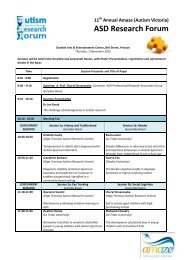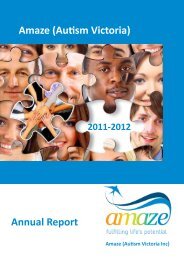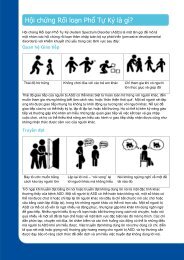Information Sheet Sharing the Diagnosis of Autism ... - Amaze
Information Sheet Sharing the Diagnosis of Autism ... - Amaze
Information Sheet Sharing the Diagnosis of Autism ... - Amaze
You also want an ePaper? Increase the reach of your titles
YUMPU automatically turns print PDFs into web optimized ePapers that Google loves.
<strong>Information</strong> <strong>Sheet</strong><br />
<strong>Sharing</strong> <strong>the</strong> <strong>Diagnosis</strong> <strong>of</strong> <strong>Autism</strong> Spectrum<br />
Disorder<br />
Written by Kirsty Kerr, Compiled by <strong>Autism</strong> Victoria, March 2006, Reviewed and updated<br />
April 2011<br />
“Our child has been diagnosed with an<br />
<strong>Autism</strong> Spectrum Disorder – how can we tell<br />
our friends and <strong>the</strong> rest <strong>of</strong> <strong>the</strong> family”<br />
“How much should we tell our child’s school<br />
about <strong>the</strong>ir <strong>Autism</strong> Spectrum Disorder”<br />
“Do we have to tell anyone about <strong>the</strong><br />
diagnosis”<br />
These are some <strong>of</strong> <strong>the</strong> questions that<br />
families frequently ask. This article gives you<br />
some answers, ideas and suitable resources<br />
to help you resolve <strong>the</strong>se questions.<br />
When a diagnosis <strong>of</strong> <strong>Autism</strong> Spectrum<br />
Disorder (ASD) is made, family, friends (and<br />
sometimes <strong>the</strong> individual <strong>the</strong>mselves) want<br />
to learn more about what <strong>the</strong> diagnosis<br />
means. They look for more information for<br />
<strong>the</strong>mselves, and <strong>the</strong>n arrive at <strong>the</strong> dilemma<br />
<strong>of</strong> whom to share this information with, and<br />
when.<br />
This article aims to help with <strong>the</strong> process.<br />
There is also information for individuals with<br />
ASD <strong>the</strong>mselves about sharing <strong>the</strong>ir<br />
diagnosis with o<strong>the</strong>rs. All books referred to<br />
in <strong>the</strong> article are available for loan from <strong>the</strong><br />
<strong>Autism</strong> Victoria library (#accession number<br />
noted in brackets).<br />
Informing Siblings<br />
Explaining <strong>the</strong> diagnosis to bro<strong>the</strong>rs and<br />
sisters will differ depending on <strong>the</strong>ir age. It is<br />
important to remember that conversations<br />
about <strong>the</strong> sibling with ASD should be<br />
repeated as <strong>the</strong> bro<strong>the</strong>r or sister grows, so<br />
that a clearer picture <strong>of</strong> <strong>the</strong> diagnosis and its<br />
implications can be built by <strong>the</strong> sibling as<br />
<strong>the</strong>ir cognitive ability becomes more<br />
sophisticated. Open <strong>the</strong> lines <strong>of</strong><br />
communication by telling <strong>the</strong> sibling <strong>the</strong>y<br />
can ask questions about autism whenever<br />
<strong>the</strong>y think <strong>of</strong> <strong>the</strong>m.<br />
Children aged 2‐3 years will need a clear,<br />
short explanation about <strong>the</strong> sibling’s<br />
difficulties, most probably without divulging<br />
<strong>the</strong> ASD label. Sentences like ‘Talking is hard<br />
for Billy’, which state behaviours <strong>the</strong> sibling<br />
<strong>Autism</strong> Victoria trading as <strong>Amaze</strong> T: 1300 308 699 W: www.amaze.org.au 1
can easily see are recommended. Pre‐school<br />
aged siblings typically ask a lot <strong>of</strong> ‘why’<br />
questions, which provides an opening for<br />
parents to discuss <strong>the</strong> reasons behind <strong>the</strong><br />
ASD child’s behaviour. Parents can provide<br />
answers like ‘Billy finds it hard to play. His<br />
brain works a little differently from yours<br />
and mine. He finds it hard to pretend with<br />
toys like we can’.<br />
Early primary school aged siblings (6‐9 years)<br />
will be able to take in <strong>the</strong> former<br />
explanation, plus similar explanations about<br />
o<strong>the</strong>r areas <strong>of</strong> difficulty for <strong>the</strong> sibling. They<br />
will also be able to understand more<br />
abstract explanations, such as ‘Billy finds it<br />
hard to understand how o<strong>the</strong>r people feel’.<br />
In addition, siblings <strong>of</strong> this age can<br />
understand <strong>the</strong> explanation that <strong>the</strong> sum <strong>of</strong><br />
<strong>the</strong>se difficulties toge<strong>the</strong>r is called ‘autism’.<br />
Children <strong>of</strong> this age may grapple with<br />
unlikely scenarios like ‘Can I catch autism’,<br />
‘Did I do something to cause my sibling’s<br />
autism’ Children may not voice <strong>the</strong>se<br />
concerns, so it is important to stop any<br />
misconceptions by explaining that autism is<br />
not contagious, it is caused by brain<br />
differences from when <strong>the</strong> sibling was very<br />
young, and that nei<strong>the</strong>r parents nor siblings<br />
cause <strong>the</strong> autism. The child should also be<br />
reassured that autism is not life threatening,<br />
and that both <strong>the</strong>y and <strong>the</strong>ir sibling are<br />
loved and valued equally, despite <strong>the</strong>ir<br />
differences.<br />
Siblings aged 9 years and into adolescence<br />
can understand more detailed written<br />
information about autism. The posters<br />
‘What is <strong>Autism</strong>’ and ‘What is Asperger<br />
Syndrome’ that are available free <strong>of</strong> charge<br />
from <strong>Autism</strong> Victoria are a concise starting<br />
point for discussion about <strong>the</strong> characteristics<br />
<strong>of</strong> ASD. Parents can talk about <strong>the</strong> specific<br />
behaviours displayed by <strong>the</strong> sibling, and how<br />
this fits with <strong>the</strong> characteristics <strong>of</strong> autism.<br />
Questions arising from this discussion may<br />
be ‘When will he get better’ and ‘Who will<br />
care for him when he gets older’ It is useful<br />
for parents to think about how <strong>the</strong>y might<br />
respond to such questions. An excellent<br />
book for parents providing a more in depth<br />
explanation <strong>of</strong> siblings’ ability to understand<br />
autism at different ages is ‘Siblings <strong>of</strong><br />
Children with <strong>Autism</strong>: A guide for families’ by<br />
Sandra Harris (#2526).<br />
There are also a variety <strong>of</strong> children’s books<br />
to help parents explain to siblings <strong>the</strong><br />
differences <strong>the</strong>ir bro<strong>the</strong>r or sister has as a<br />
result <strong>of</strong> <strong>the</strong>ir diagnosis. Parents may<br />
choose to read <strong>the</strong> books <strong>the</strong>mselves and<br />
use <strong>the</strong> information as a basis to answer<br />
<strong>the</strong>ir child’s questions in a developmentally<br />
appropriate way. Alternatively, parents may<br />
read <strong>the</strong> book with <strong>the</strong> sibling, and <strong>the</strong>n<br />
have a discussion with <strong>the</strong> sibling.<br />
For siblings 3‐6 years<br />
Various picture books, such as ‘My bro<strong>the</strong>r<br />
Sammy’ by B. Edwards & D. Armitage<br />
(#1900), and ‘My Bro<strong>the</strong>r is Different’ by L.<br />
Gorrod (#1692) show <strong>the</strong> characteristics <strong>of</strong><br />
autism through stories with bright<br />
illustrations. The first book does not use <strong>the</strong><br />
label ‘autism’, <strong>the</strong> second one does.<br />
Siblings 7 years and over<br />
For a sibling with a diagnosis <strong>of</strong> autism, <strong>the</strong><br />
book ‘Children with <strong>Autism</strong>, a booklet for<br />
bro<strong>the</strong>rs and sisters’ by J. Davies (#1034) is<br />
helpful. For a sibling with a diagnosis <strong>of</strong> less<br />
<strong>Autism</strong> Victoria trading as <strong>Amaze</strong> T: 1300 308 699 W: www.amaze.org.au 2
severe autism, Asperger’s Syndrome, or<br />
PDD‐NOS, <strong>the</strong> book ‘Able Autistic Children:<br />
Children with Asperger’s Syndrome’(#1138),<br />
also by Julie Davies is recommended.<br />
Both <strong>of</strong> <strong>the</strong>se books explain what <strong>the</strong><br />
diagnosis means, including <strong>the</strong> difficulties<br />
<strong>the</strong>ir sibling may have, comments about <strong>the</strong><br />
positives and negatives <strong>of</strong> having a bro<strong>the</strong>r<br />
or sister with ASD, and how <strong>the</strong> child might<br />
explain to o<strong>the</strong>rs about <strong>the</strong>ir siblings’<br />
diagnosis. The books also cover questions<br />
about ASD <strong>the</strong> sibling may not have asked,<br />
such as ‘when will he get better’, so as to<br />
clear up any misconceptions <strong>the</strong> sibling may<br />
have. Ano<strong>the</strong>r useful book is ‘Everybody is<br />
Different’ by F. Bleach (#2316) that explains<br />
<strong>the</strong> difficulties <strong>of</strong> autism, as well as covering<br />
questions siblings frequently ask<br />
A fiction book for children <strong>of</strong> this age group,<br />
where <strong>the</strong> main character has a bro<strong>the</strong>r with<br />
autism is ‘Dolphins Dance’ by Jutta Goetze<br />
(#2341). It is useful for siblings to know that<br />
<strong>the</strong>y are not alone ‐ that o<strong>the</strong>r children<br />
experience some <strong>of</strong> <strong>the</strong> same issues as <strong>the</strong>y<br />
do.<br />
<br />
<br />
<br />
<br />
overload, or problems with <strong>the</strong><br />
organisation needed to complete a task.<br />
Accommodations can be made for <strong>the</strong><br />
child’s learning style, such as presenting<br />
more information visually.<br />
Accommodations can be made in <strong>the</strong><br />
child’s workload, if it can be<br />
acknowledged that it may take <strong>the</strong><br />
student longer to complete tasks, even<br />
when trying as hard as o<strong>the</strong>r students.<br />
Social difficulties at break‐times can be<br />
acknowledged, and <strong>the</strong> child supported<br />
or allowed to do alternative activities at<br />
recess and lunch.<br />
The child can be encouraged in <strong>the</strong>ir<br />
areas <strong>of</strong> strength or interest.<br />
<strong>Sharing</strong> <strong>the</strong> diagnosis with <strong>the</strong> teaching staff<br />
is best done in a face‐to‐face meeting. The<br />
parent may wish to include o<strong>the</strong>r<br />
pr<strong>of</strong>essionals who have assisted <strong>the</strong> child (eg<br />
speech pathologist, psychologist,<br />
occupational <strong>the</strong>rapist), so <strong>the</strong>se<br />
pr<strong>of</strong>essionals can also help in explaining <strong>the</strong><br />
child’s needs, strengths and difficulties.<br />
Alternatively, copies <strong>of</strong> any assessment<br />
reports completed may be shared with <strong>the</strong><br />
teaching staff, if recommendations are made<br />
in <strong>the</strong> reports specifically about education<br />
issues. The process <strong>of</strong> information sharing<br />
with teaching staff may need to be repeated<br />
each year, for each new teacher.<br />
Telling your child’s teaching staff<br />
Some advantages in sharing your child’s<br />
diagnosis with <strong>the</strong>ir teaching staff are:<br />
<br />
Accommodations can be made for <strong>the</strong><br />
child’s behaviour, which may appear<br />
‘naughty’, when it is really <strong>the</strong> result <strong>of</strong><br />
lack <strong>of</strong> social understanding, sensory<br />
A note to parents: in fairness to teaching<br />
staff, it is best to ensure any written<br />
<strong>Autism</strong> Victoria trading as <strong>Amaze</strong> T: 1300 308 699 W: www.amaze.org.au 3
information about <strong>Autism</strong> Spectrum<br />
Disorders given is very concise, so staff can<br />
very quickly gain an understanding, and<br />
gives some specific strategies to use for <strong>the</strong><br />
student. Even <strong>the</strong> best intentioned teacher<br />
or aide may not have <strong>the</strong> time to read a<br />
whole text book in a timely enough matter<br />
to apply <strong>the</strong> information for <strong>the</strong> student.<br />
Using <strong>the</strong> posters from <strong>the</strong> <strong>Autism</strong> Victoria<br />
information packages*, discussing which<br />
points apply to <strong>the</strong> student, and which<br />
strategies have worked in <strong>the</strong> past for <strong>the</strong><br />
specific child is an excellent start. O<strong>the</strong>r<br />
issues can <strong>the</strong>n be discussed during <strong>the</strong> year<br />
as <strong>the</strong>y arise. The Asperger Syndrome<br />
information kit has a concise summary <strong>of</strong><br />
difficulties for <strong>the</strong> student, and suggested<br />
modifications.<br />
*These information packages can be<br />
obtained free <strong>of</strong> charge by contacting <strong>Autism</strong><br />
Victoria.<br />
A note to teachers: Every child with ASD is<br />
unique in <strong>the</strong>ir expression <strong>of</strong> <strong>the</strong> key<br />
characteristics <strong>of</strong> <strong>the</strong>se disorders, so having<br />
one student with ASD in <strong>the</strong> past does not<br />
mean you can immediately apply <strong>the</strong> same<br />
strategies to <strong>the</strong> next student with ASD.<br />
Seek information specific to each child from<br />
parents or past teachers.<br />
Talking about ASD with classmates<br />
and young friends<br />
Often in lower primary school, <strong>the</strong> child’s<br />
classmates begin to notice differences and<br />
ask questions about <strong>the</strong> student with ASD.<br />
The teacher may choose to respond to<br />
individual children as questions arise, or<br />
<strong>the</strong>re may be several reasons to inform all<br />
<strong>the</strong> class toge<strong>the</strong>r about <strong>the</strong> diagnosis.<br />
Reasons to inform classmates may include:<br />
<br />
Preventing bullying or teasing by<br />
pointing out why <strong>the</strong> child has difficulties<br />
in some areas. The teacher can<br />
encourage students to be supportive and<br />
helpful to <strong>the</strong> student with ASD, by<br />
informing <strong>the</strong>m about specific ways to<br />
help. (eg. ‘Billy finds it difficult when<br />
people walk too close to him in line. If<br />
Billy looks upset, move one arm’s length<br />
away so he can have some space’).<br />
Stopping misinformation about <strong>the</strong><br />
student being circulated in o<strong>the</strong>r<br />
student’s gossip. (such as ’Billy is weird,<br />
don’t play with him’)<br />
Preventing ‘perceived favouritism’ –<br />
helping classmates become more<br />
accepting that some accommodations<br />
may be made for <strong>the</strong> student with ASD,<br />
that won’t be available for <strong>the</strong>m. A<br />
lovely picture book for lower primary<br />
aged students along <strong>the</strong>se lines is<br />
‘Looking after Louis’ by Ely and Dunbar<br />
(#2640).<br />
Before disclosing <strong>the</strong> diagnosis to <strong>the</strong><br />
student’s classmates, it is imperative that<br />
teaching staff gain permission from <strong>the</strong><br />
parents <strong>of</strong> <strong>the</strong> child with ASD. The<br />
diagnostic label should only be shared if<br />
parents wish for this to happen. Ano<strong>the</strong>r<br />
consideration is whe<strong>the</strong>r <strong>the</strong> student with<br />
ASD should be present or not present when<br />
<strong>the</strong> class is learning about ASD. The child’s<br />
ability to understand that <strong>the</strong> discussion is<br />
about <strong>the</strong>m will influence this decision.<br />
A beautiful book to introduce lower primary<br />
aged students to <strong>the</strong> needs <strong>of</strong> a classmate<br />
with autism is ‘My friend with <strong>Autism</strong>’ by<br />
Beverly Bishop (# 2336). For a classmate<br />
<strong>Autism</strong> Victoria trading as <strong>Amaze</strong> T: 1300 308 699 W: www.amaze.org.au 4
with Asperger Syndrome, ‘This is Asperger<br />
Syndrome’ by Elise Gagnon and Brenda<br />
Smith Myles (# 2034) is recommended.<br />
Parents may also want to visit <strong>the</strong> school<br />
during class‐time to talk to <strong>the</strong> class about<br />
ASD, <strong>the</strong>ir own child’s unique needs, and<br />
how classmates can be a ‘good friend’. Carol<br />
Gray has developed a lesson plan ‘The Sixth<br />
Sense‐II’ (#2314) through which teachers can<br />
introduce <strong>the</strong> social difficulties <strong>of</strong> a student<br />
with ASD to <strong>the</strong>ir classmates aged 7‐12<br />
years.<br />
For upper primary and lower secondary<br />
students ‘What does it mean to have<br />
<strong>Autism</strong>’ by L. Spilsbury (#2380), and ‘Can I<br />
tell you about Asperger Syndrome’ by Jude.<br />
Welton (# 2387) are useful for facilitating<br />
discussion about autism and Asperger’s<br />
Syndrome respectively.<br />
For upper secondary students, <strong>the</strong> <strong>Autism</strong><br />
Victoria poster kit, with A3 size posters<br />
covering <strong>the</strong> characteristics <strong>of</strong> <strong>Autism</strong> and<br />
Asperger Syndrome is a recommended<br />
starting point for discussion. The resource<br />
package about <strong>the</strong> novel The Curious<br />
Incident <strong>of</strong> <strong>the</strong> Dog in <strong>the</strong> Night‐time by<br />
Mark Haddon (#2305) is also useful. These<br />
are all available free <strong>of</strong> charge from <strong>the</strong><br />
<strong>Autism</strong> Victoria <strong>of</strong>fice.<br />
Curriculum ideas: To promote tolerance <strong>of</strong><br />
difference, without using <strong>the</strong> ASD label in<br />
regards to a particular child, teachers may<br />
wish to try one <strong>of</strong> <strong>the</strong> following activities.<br />
1. Discuss in <strong>the</strong> <strong>the</strong>me <strong>of</strong> ‘difference’, that<br />
everyone has strengths and weaknesses.<br />
Have every student identify one strength<br />
and something <strong>the</strong>y would like to<br />
improve. Use <strong>the</strong> strengths to make a<br />
class ‘Yellow Pages’ directory, with a<br />
page from each student advertising <strong>the</strong>ir<br />
strength. When a student is having<br />
difficulty (eg with <strong>the</strong> computer), have<br />
<strong>the</strong>m look in <strong>the</strong> class ‘Yellow Pages’ to<br />
identify ano<strong>the</strong>r student to help (maybe<br />
<strong>the</strong> person with ASD). apabilities can<br />
<strong>the</strong>n be shared, and <strong>the</strong> person with ASD<br />
is sought out for <strong>the</strong>ir strength, be it<br />
ma<strong>the</strong>matics, puzzles, remembering<br />
facts, sharpening pencils, telling a joke,<br />
drawing, etc.<br />
2. Setting a school project on ‘differences’,<br />
or covering <strong>the</strong> <strong>the</strong>me <strong>of</strong> difference in a<br />
series <strong>of</strong> classes. Various cultures and<br />
nationalities, disabilities and abilities<br />
could be covered, ASD included, with<br />
students reporting back to <strong>the</strong> rest <strong>of</strong><br />
<strong>the</strong> class. If a project is set for <strong>the</strong> class,<br />
randomly assign topics so that each<br />
student has a different topic.<br />
3. Reading books about accepting<br />
difference, such as ‘Why can’t Charlie<br />
Talk’ by Debbie Spencer (#2559),<br />
‘Trevor, Trevor’ by D Twachtman‐Cullen<br />
(#2318) (lower primary age students) or<br />
‘Amazingly Alphie: Understanding and<br />
accepting different ways <strong>of</strong> being’ by Roz<br />
Espin (#2626) (upper primary age<br />
students).<br />
Introducing <strong>the</strong> child to <strong>the</strong>ir<br />
diagnosis<br />
As children grow older, parents <strong>of</strong>ten<br />
grapple with <strong>the</strong> question <strong>of</strong> if, and when to<br />
inform <strong>the</strong> child <strong>of</strong> <strong>the</strong>ir diagnosis. The<br />
benefits <strong>of</strong> explaining to <strong>the</strong> child about <strong>the</strong>ir<br />
diagnosis <strong>of</strong> ASD include:<br />
<br />
<br />
The child has an answer for <strong>the</strong>ir<br />
difficulties, which <strong>the</strong>y may previously<br />
have attributed to inadequacies in<br />
<strong>the</strong>mselves.<br />
The child can gain more insight into <strong>the</strong>ir<br />
own learning style, and know what kind<br />
<strong>of</strong> modifications (eg.visual supports) will<br />
help <strong>the</strong>m learn and care for <strong>the</strong>mselves<br />
best.<br />
<strong>Autism</strong> Victoria trading as <strong>Amaze</strong> T: 1300 308 699 W: www.amaze.org.au 5
Luke Jackson, an adolescent with Asperger<br />
Syndrome and author <strong>of</strong> ‘Freaks, Geeks and<br />
Asperger Syndrome’ (#2252) advocates<br />
telling a child about <strong>the</strong>ir diagnosis as soon<br />
as possible. At 12 years <strong>of</strong> age, he noticed<br />
<strong>the</strong> behaviours <strong>of</strong> his younger bro<strong>the</strong>r<br />
(diagnosed with autism) were similar to his<br />
own, and began to ask questions. He had<br />
felt he was different for a long time and was<br />
relieved to have a name for why he was<br />
different. He wished he had been informed<br />
sooner.<br />
So if parents have decided <strong>the</strong>y want to<br />
inform <strong>the</strong> child about <strong>the</strong>ir diagnosis, and<br />
feel <strong>the</strong> child can understand <strong>the</strong> language<br />
involved, <strong>the</strong> next decision is exactly what to<br />
say. Parents may wish to talk to <strong>the</strong> child<br />
about <strong>the</strong>ir strengths and difficulties, and<br />
<strong>the</strong>n inform <strong>the</strong> child that <strong>the</strong> name for<br />
<strong>the</strong>se qualities is <strong>Autism</strong>/Asperger’s/PDD‐<br />
NOS. Carol Gray has developed <strong>the</strong> very<br />
useful format ‘Pictures <strong>of</strong> Me’ (#1615) to<br />
introduce children with High‐Functioning<br />
<strong>Autism</strong> and Asperger Syndrome to <strong>the</strong>ir<br />
diagnosis.<br />
The table opposite indicates some common<br />
areas <strong>of</strong> strength and difficulty for children<br />
with ASD, and ways parents might discuss<br />
<strong>the</strong>se with <strong>the</strong>ir child.<br />
A verbatim conversation between Jennifer<br />
Overton, and her 9‐year‐old son, in which<br />
she explains his diagnosis to him is printed in<br />
<strong>the</strong> book ‘Coming out Asperger’ edited by<br />
Dinah Murray (#2669). Parents may wish to<br />
use this actual conversation as a rough<br />
model about how <strong>the</strong>ir own conversation<br />
with <strong>the</strong>ir child may unfold.<br />
Strengths & Difficulties for<br />
children with ASDs:<br />
Strength<br />
Good memory for<br />
facts and/or for<br />
visually presented<br />
information<br />
Good ability to<br />
solve non‐verbal<br />
problems<br />
Attention to detail<br />
Honesty<br />
Difficulty<br />
Understanding<br />
social interaction<br />
Difficulty with<br />
language<br />
Rigid thinking or<br />
repetitive<br />
behaviours<br />
Examples <strong>of</strong> possible<br />
explanations<br />
“You can always remember <strong>the</strong><br />
directions to get to when we<br />
are travelling”<br />
“You remind me about<br />
important things like when<br />
birthdays are coming up”<br />
“You always remember who<br />
was at <strong>the</strong> family Christmas<br />
party”<br />
“You are good at finding things”<br />
“You are an expert on animals”<br />
“You can do jigsaws so quickly”<br />
“You can put equipment back<br />
toge<strong>the</strong>r without instructions”<br />
“You make sure things are done<br />
in a thorough way”<br />
“You help o<strong>the</strong>rs notice errors”<br />
“You tell people exactly what<br />
you think <strong>of</strong> <strong>the</strong>m”<br />
“You are always truthful”<br />
Explanations (add examples<br />
specific to your child)<br />
“Sometimes you don’t notice<br />
how o<strong>the</strong>r people feel”<br />
“You find it hard to follow o<strong>the</strong>r<br />
children’s games”<br />
“Sometimes you don’t<br />
understand what o<strong>the</strong>rs are<br />
saying”<br />
“Sometimes you aren’t able to<br />
follow instructions when o<strong>the</strong>rs<br />
speak <strong>the</strong>m”<br />
“You have to have things done<br />
in a particular way every time”<br />
“You like to be <strong>the</strong> boss in<br />
games”<br />
“You get upset if things change”<br />
“You find it hard to forget when<br />
something upsets you”<br />
The following books have worksheets and<br />
activities to help children understand <strong>the</strong>ir<br />
autism (from ages 8 years onwards):<br />
<strong>Autism</strong> Victoria trading as <strong>Amaze</strong> T: 1300 308 699 W: www.amaze.org.au 6
‘I am Special: Introducing children and<br />
young people to <strong>the</strong>ir autistic spectrum<br />
disorder’ by Peter Vermeulen (# 2003)<br />
‘What does it mean to be me A workbook<br />
explaining self awareness and life lessons to<br />
<strong>the</strong> child or youth with High‐Functioning<br />
<strong>Autism</strong> or Asperger’s Syndrome’ by<br />
Ca<strong>the</strong>rine Faherty (# 1892)<br />
The following books introduce children to<br />
<strong>the</strong> characteristics <strong>of</strong> Asperger Syndrome:<br />
‘Asperger’s, huh ‐ A child’s perspective’, by<br />
R.G.Schnurr (#2103)<br />
‘What is Asperger Syndrome, and how will it<br />
affect me’, by M. Ives (# 1947).<br />
behaviour by his magic helmet, which<br />
interprets difficult situations for him. This is<br />
a set <strong>of</strong> 3 books for ages 5‐8 (#2489), and<br />
‘Ben, his helmet, and bees in your bonnet’<br />
(#2588) for ages 9‐12 is now available.<br />
‘Different like Me’ by Jennifer Elder (#2683)<br />
looks at famous figures who showed<br />
behaviours different from <strong>the</strong> norm, and<br />
may have been diagnosed with an ASD if<br />
assessed today. Many <strong>of</strong> <strong>the</strong> figures are<br />
famous in <strong>the</strong> USA, and not recognisable to<br />
Australian children, however reading about<br />
<strong>the</strong>ir achievements should still be an<br />
encouragement for children with an ASD<br />
aged 8‐12 years.<br />
‘The mystery <strong>of</strong> a special kid’, by Josie<br />
Santomauro (# 1720)<br />
For children with Asperger Syndrome, two<br />
common reactions to being told <strong>the</strong>ir<br />
diagnosis are relief, or vehement denial;<br />
insisting that nothing is wrong with <strong>the</strong>m<br />
and that everyone else has <strong>the</strong> problem. For<br />
parents <strong>of</strong> children with Asperger Syndrome<br />
who suspect <strong>the</strong>ir child may reject <strong>the</strong><br />
suggestions that <strong>the</strong>y are different, a less<br />
direct approach may be useful. There are<br />
several children’s books where <strong>the</strong> main<br />
characters/heroes <strong>of</strong> <strong>the</strong> story are children<br />
with Asperger Syndrome. Reading <strong>the</strong>se<br />
toge<strong>the</strong>r may lead <strong>the</strong> child to identify that<br />
<strong>the</strong>y <strong>the</strong>mselves have <strong>the</strong> same<br />
characteristics. This is a good way to start a<br />
discussion in a non‐threatening way.<br />
Kathy Hoopman has written several books,<br />
including ‘Blue Bottle Mystery’(#2013), ‘Of<br />
Mice and Aliens’(#2014) (for upper primary<br />
aged children) and ‘Haze’ (#2324) (for<br />
adolescents).<br />
Nelle Francis has written a series <strong>of</strong> books<br />
‘Ben and his Helmet’ in which <strong>the</strong> hero, Ben,<br />
has Asperger Syndrome. Ben is guided in his<br />
Family and friends<br />
After receiving a diagnosis for <strong>the</strong>ir child,<br />
and in <strong>the</strong> years that follow, parents benefit<br />
from <strong>the</strong> understanding and assistance <strong>of</strong><br />
family and friends. Unfortunately some<br />
parents experience <strong>the</strong> loss <strong>of</strong> contact with<br />
those individuals who do not know how to<br />
assist, are confronted by <strong>the</strong> child’s<br />
behaviour, or who are in denial that <strong>the</strong> child<br />
has a lifelong difficulty. Anna Tullemans has<br />
written booklet <strong>of</strong> tips ‘Talking to friends and<br />
family about <strong>the</strong> diagnosis’ (#2599) covering<br />
why and how to share <strong>the</strong> child’s diagnosis<br />
with family and friends.<br />
As per <strong>the</strong> suggestions above about talking<br />
to <strong>the</strong> child’s teaching staff, parents may<br />
similarly invite friends and family to get<br />
toge<strong>the</strong>r as a group, disclose <strong>the</strong> child’s<br />
diagnosis, provide written information about<br />
<strong>Autism</strong> Victoria trading as <strong>Amaze</strong> T: 1300 308 699 W: www.amaze.org.au 7
ASD’s, discuss how this relates to <strong>the</strong>ir child,<br />
and share <strong>the</strong> strategies which are to be<br />
used with <strong>the</strong> child. Parents may also<br />
suggest that family and friends contact<br />
<strong>Autism</strong> Victoria for more information.<br />
Informing <strong>the</strong> broader community<br />
Which people in <strong>the</strong> community should<br />
know about <strong>the</strong> child’s diagnosis is a matter<br />
<strong>of</strong> personal preference. Individuals who may<br />
benefit from knowing could include<br />
neighbours, service people whom <strong>the</strong> family<br />
sees regularly, local shopkeepers, etc. A<br />
common reason for sharing this information<br />
is to provide an explanation for <strong>the</strong> child’s<br />
unusual behaviour, or to indicate how such<br />
people may better interact with, and<br />
respond to <strong>the</strong> child. In order to prevent<br />
lengthy explanations, some parents choose<br />
to disclose <strong>the</strong> child’s area <strong>of</strong> difficulty<br />
relevant to <strong>the</strong> situation (eg ‘Billy has<br />
difficulty learning to speak, please use very<br />
short sentences for him’), o<strong>the</strong>r parents give<br />
a fuller explanation including <strong>the</strong> ASD label.<br />
A recent media story depicted parents<br />
dressing <strong>the</strong>ir child in a t‐shirt proclaiming<br />
his ASD diagnosis, in order to stop <strong>the</strong><br />
staring and comments <strong>of</strong> o<strong>the</strong>rs in response<br />
to <strong>the</strong> child’s behaviour. A more diplomatic<br />
alternative for explaining <strong>the</strong> child’s<br />
diagnosis to o<strong>the</strong>rs in <strong>the</strong> community is an<br />
<strong>Autism</strong> Victoria ‘alert card’. This is a<br />
business‐sized card giving a succinct<br />
sentence explaining ASD’s, and <strong>Autism</strong><br />
Victoria’s telephone number for people to<br />
find out more information. Parents can<br />
hand this to people in <strong>the</strong> community who<br />
are curious, and it is especially helpful if a<br />
parent needs to leave an event or shop midtransaction<br />
(without time for verbal<br />
explanation) to attend to <strong>the</strong> person with<br />
ASD. The alert cards are available to<br />
purchase from <strong>Autism</strong> Victoria, and are an<br />
ideal template from which to make up an<br />
alert card personalised to <strong>the</strong> individual child<br />
with ASD.<br />
Disclosing your own diagnosis<br />
Teenagers: Luke Jackson, a teenager with<br />
Asperger Syndrome, gives <strong>the</strong> following<br />
advice about disclosure in his book ‘Freaks,<br />
Geeks and Asperger Syndrome’ (#2252). He<br />
suggests that <strong>the</strong> diagnosis be shared with<br />
teachers, so <strong>the</strong>y can make accommodations<br />
and be supportive <strong>of</strong> <strong>the</strong> student. He also<br />
suggests that <strong>the</strong> diagnosis be shared with<br />
supportive friends. As a person with<br />
Asperger Syndrome, he concedes it is<br />
difficult for him to know who will be<br />
supportive, and urges parents to help <strong>the</strong>ir<br />
children with identifying appropriate people.<br />
Luke usually waits until someone comments<br />
on his unusual behaviours, <strong>the</strong>n he discloses<br />
his diagnosis by explaining that his<br />
difficulties are caused by ‘differences in his<br />
brain’, which collectively are called<br />
Asperger’s Syndrome.<br />
O<strong>the</strong>r advice for teenagers wanting to<br />
disclose <strong>the</strong>ir diagnosis to <strong>the</strong>ir age peers<br />
can be found in <strong>the</strong> chapters written by Heta<br />
Puki & Penny Barrat in ‘Coming out<br />
Asperger’ edited by Dinah Murray (#2669).<br />
Adults: Several adults with autism spectrum<br />
disorders have written about <strong>the</strong>ir<br />
experiences with disclosing <strong>the</strong>ir diagnosis,<br />
and give suggestions to o<strong>the</strong>rs planning to<br />
do <strong>the</strong> same. Lianne Holliday Willey is an<br />
adult diagnosed with Asperger Syndrome.<br />
She likes to share her diagnosis <strong>of</strong>ten, in<br />
order to spread knowledge about Asperger<br />
Syndrome. She writes in her book<br />
‘Pretending to be Normal’ (#2565) about<br />
using a business size card to inform people<br />
she meets about her diagnosis.<br />
It reads:<br />
<strong>Autism</strong> Victoria trading as <strong>Amaze</strong> T: 1300 308 699 W: www.amaze.org.au 8
“I have Asperger’s Syndrome, a<br />
neurobiological disorder that sometimes<br />
makes it difficult for me to speak and act<br />
calmly and rationally. If I have given you this<br />
card, it probably means I think I am acting in<br />
a way that may be disturbing to you. In<br />
short, Asperger’s Syndrome can make it<br />
difficult for me to: speak slowly, refrain from<br />
interrupting, control my hand movements<br />
and my blinking. It also makes it hard for me<br />
to follow your thoughts so that I might<br />
misunderstand what you are trying to say or<br />
do. It would help me if you would speak<br />
calmly and answer any questions I might<br />
have, clearly and completely. I apologise if<br />
my behaviours seem inappropriate. For<br />
more information contact … (insert your<br />
<strong>Autism</strong> association’s details) …”<br />
In summary, individuals with an ASD who<br />
have experience sharing <strong>the</strong>ir diagnosis<br />
suggest:<br />
<br />
<br />
<br />
<br />
Choosing carefully who to tell. Involve a<br />
trusted person to help in making <strong>the</strong><br />
choice <strong>of</strong> who to inform.<br />
Thinking carefully beforehand about <strong>the</strong><br />
exact words to use.<br />
Using ei<strong>the</strong>r written or verbal<br />
explanations for <strong>the</strong> o<strong>the</strong>r person to<br />
help in <strong>the</strong>ir understanding <strong>of</strong> ASD.<br />
Being prepared that disclosing <strong>the</strong><br />
diagnosis may make o<strong>the</strong>rs react<br />
negatively towards you. People who<br />
react in this fashion are not helpful<br />
people to stay involved with.<br />
Lianne <strong>of</strong>fers some interesting anecdotes<br />
about her experiences <strong>of</strong> disclosing her<br />
diagnosis, both positive and negative, and<br />
her system for deciding who, and how to<br />
tell.<br />
Stephen Shore, an adult with ASD, suggests<br />
individuals think about what <strong>the</strong>y hope to<br />
gain by disclosure. He discloses his diagnosis<br />
on a ‘need to know’ basis, and <strong>of</strong>ten just<br />
discloses specific deficits (eg. difficulty with<br />
sensory information) to o<strong>the</strong>rs when a<br />
difficult situation arises, ra<strong>the</strong>r than stating<br />
that he has an ASD. He has developed a<br />
good guideline letter to help individuals<br />
disclose <strong>the</strong>ir diagnosis to <strong>the</strong>ir employer,<br />
which helps individuals outline <strong>the</strong> specific<br />
aspects <strong>of</strong> <strong>the</strong>ir diagnosis that may impact<br />
on <strong>the</strong>ir work performance. This can be<br />
found in his chapter in ‘Asperger Syndrome<br />
and Adolescence’, edited by Lianne Holliday<br />
Willey (# 2280).<br />
____________________________________<br />
©2011 <strong>Autism</strong> Victoria trading as <strong>Amaze</strong>.<br />
Permission is granted for <strong>the</strong> content <strong>of</strong> this<br />
information sheet to be reproduced in its<br />
entirety, provided <strong>Autism</strong> Victoria is<br />
acknowledged as <strong>the</strong> source and <strong>the</strong> website<br />
address is given.<br />
<strong>Autism</strong> Victoria trading as <strong>Amaze</strong> T: 1300 308 699 W: www.amaze.org.au 9


